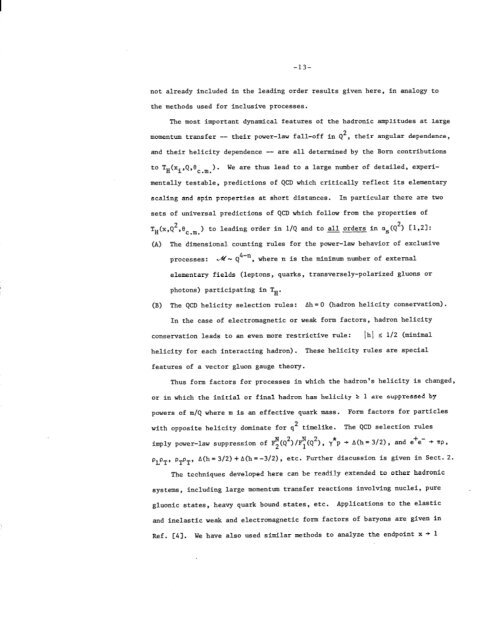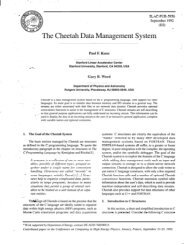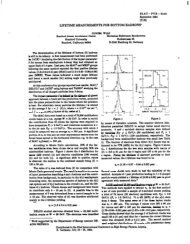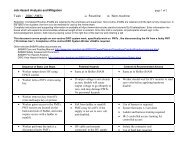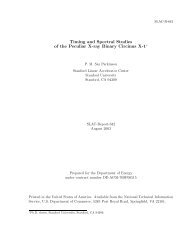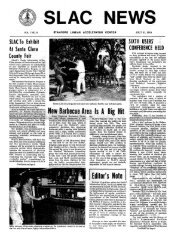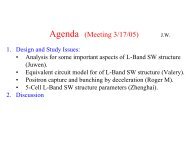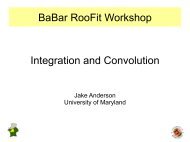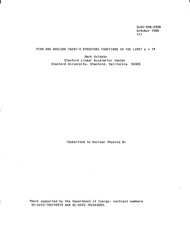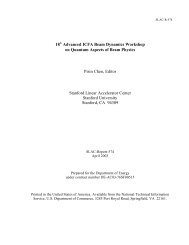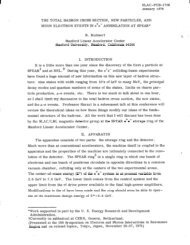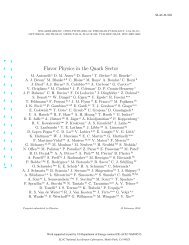slac-pub-2605 - SLAC - Stanford University
slac-pub-2605 - SLAC - Stanford University
slac-pub-2605 - SLAC - Stanford University
You also want an ePaper? Increase the reach of your titles
YUMPU automatically turns print PDFs into web optimized ePapers that Google loves.
-13-<br />
not already included in the leading order results given here, in analogy to<br />
the methods used for inclusive processes.<br />
The most important dynamical features of the hadronic amplitudes at large<br />
n<br />
momentum transfer -- their power-law fall-off in QL, their angular dependence,<br />
and their helicity dependence -- are all determined by the Born contributions<br />
to TH(xi,Q,ec m >- We are thus lead to a large number of detailed, experi-<br />
. .<br />
mentally testable, predictions of QCD which critically reflect its elementary<br />
scaling and spin properties at short distances. In particular there are two<br />
sets of universal predictions of QCD which follow from the properties of<br />
TH(x,Q2>ec . m .<br />
) to leading order in l/Q and to all orders in as(Q2) [1,21:<br />
(A) The dimensional counting rules for the power-law behavior of exclusive<br />
processes: A* Q 4-n , where n is the minimum number of external<br />
elementary fields (leptons, quarks, transversely-polarized gluons or<br />
photons) participating in TR.<br />
(B) The QCD helicity selection rules: Ah=0 (hadron helicity conservation).<br />
In the case of electromagnetic or weak form factors, hadron helicity<br />
conservation leads to an even more restrictive rule: Ihl < l/2 (minimal<br />
helicity for each interacting hadron). These helicity rules are special<br />
features of a vector gluon gauge theory.<br />
Thus form factors for processes in which the hadron's helicity is changed,<br />
or in which the initial or final hadron has helicity 5 1 are suppressed by<br />
powers of m/Q where m is an effective quark mass. Form factors for particles<br />
with opposite helicity dominate for q2 timelike. The QCD selection rules<br />
imply power-law suppression of F:(Q2)/Fy(Q2), y*p + A(h=3/2), and e+e- * w,<br />
pLpT, pTpT, A(h=3/2)+A(h=-3/2), etc. Further discussion is given in Sect. 2.<br />
The techniques developed here can be readily extended to other hadronic<br />
systems, including large momentum transfer reactions involving nuclei, pure<br />
gluonic states, heavy quark bound states, etc. Applications to the elastic<br />
and inelastic weak and electromagnetic form factors of baryons are given in<br />
Ref. [4]. We have also used similar methods to analyze the endpoint x + 1


